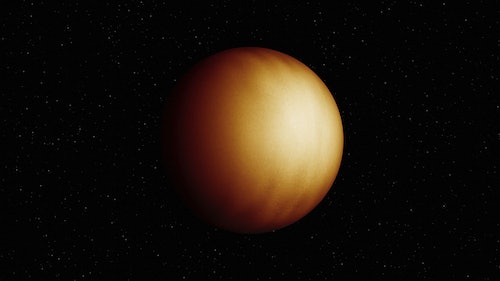JWST observations just spotted traces of water vapor, along with clues that suggest a powerful magnetic field, on exoplanet WASP-18b. Four-hundred light years away, exoplanet WASP-18b is up to some weird stuff. There’s nothing in our Solar System; it’s a gargantuan gas giant 10 times more massive than Jupiter, and it hugs its star at just five percent of the distance between Mercury and our Sun.
Forget about liquid water; at that range, WASP-18b is so hot that water molecules actually start to break down into hydrogen and oxygen. So University of Montreal astronomer and his colleagues were surprised to see the telltale fingerprint of water in the spectrum of infrared light coming from the planet. And that’s not even the strangest thing they found.
This artist’s illustration shows what WASP-18b might look like. WASP-18b is hot, but there’s hot, and then there’s hot. The planet is tidally locked to its star, which means that one side is in permanent scorching daylight, while the other half chills in perpetual darkness.
Because the daylit side always faces the star, it always faces away from astronomers here on Earth, but astronomers used a clever trick to get a look at it. Coulombe and his colleagues watched closely as the planet disappeared behind the star and then reappeared on the other side; astronomers call this a secondary eclipse, and it’s the opposite of a transit (which happens when a planet passes in front of its star). The part of the planet just below the star is almost 5,000 degrees Fahrenheit according to measurements with JWST’s Near Infrared Imager and Slitless Spectrograph (NIRISS) instrument.
But in the endless twilight of the terminator (the dim band where the dayside of the planet meets its nightside) temperatures plummet to around 2,800 degrees Fahrenheit. To be fair, that’s still hot enough to melt your face off and start snapping apart the chemical bonds that hold water molecules together. But it’s a 2,200 degrees Fahrenheit drop, and that suggests that WASP-18b’s thick, puffy atmosphere isn’t doing much to move heat around the planet — and that, in highly technical terms, is kind of weird.
are really good at moving heat around; that’s what makes weather happen. Secondary eclipse observations like this one have helped other teams of astronomers figure out whether some small, rocky exoplanets even had atmospheres (spoiler alert: ). If all the heat seems to stick close to the point just under the star, there’s probably not much of an atmosphere to move it around.
Something different is happening on WASP-18b, though. We know the gas giant has an atmosphere – it’s atmosphere, in fact. But there don’t seem to be any winds moving air or heat east and west toward the cooler nightside, even though planetary scientists expected to find exactly that.
“One possible explanation is that the planet has a strong magnetic field,” says University of Michigan astronomer , a co-author of , in a statement. That magnetic field may be forcing WASP-18b’s prevailing winds to blow north and south, instead of east and west (which is the direction in which JWST mapped temperature changes across the planet). If so, says Challener, a strong magnetic field on a planet so close to its star “would be an exciting discovery.
” And then there’s the water vapor. Water molecules start to fall apart at around 2,000 degrees Fahrenheit, which is about the lowest temperature on the blazing dayside of WASP-18b. By the time things heat up to 5,000 degrees Fahrenheit, directly underneath the nearby star’s unrelenting light, most of the water molecules in the planet’s atmosphere should have crumbled into hydrogen and oxygen.
Most, but not necessarily all. In fact, it’s likely that instruments less sensitive than JWST’s would have missed the “subtle, but precisely measured” traces of water on WASP-18b altogether. .
From: inverse
URL: https://www.inverse.com/science/this-super-hot-exoplanet-is-even-stranger-than-we-thought



